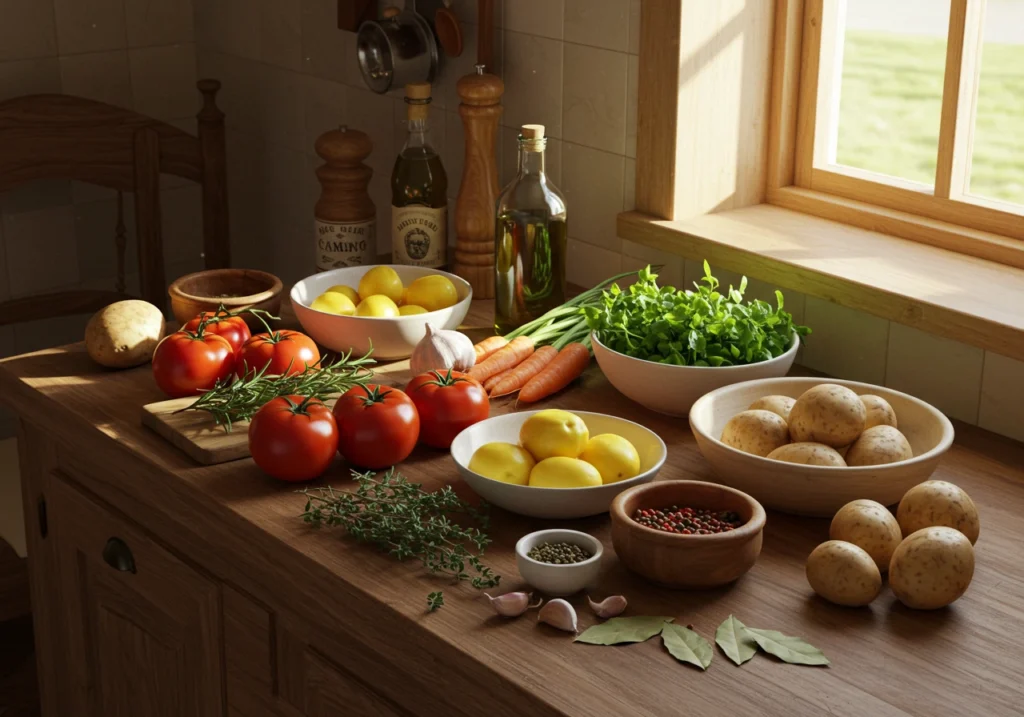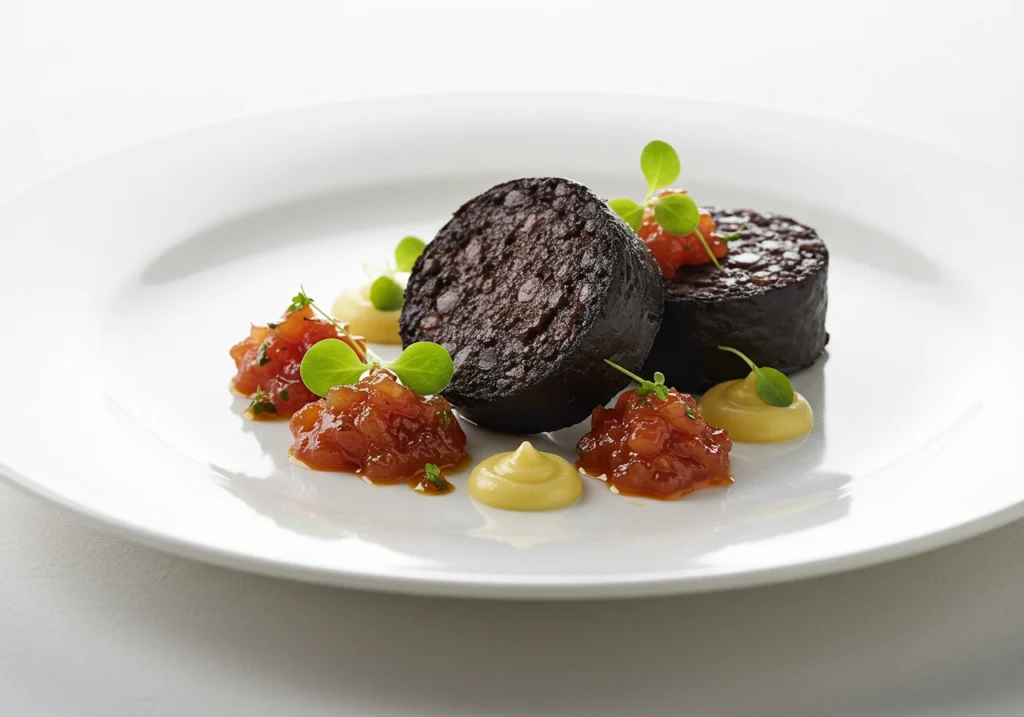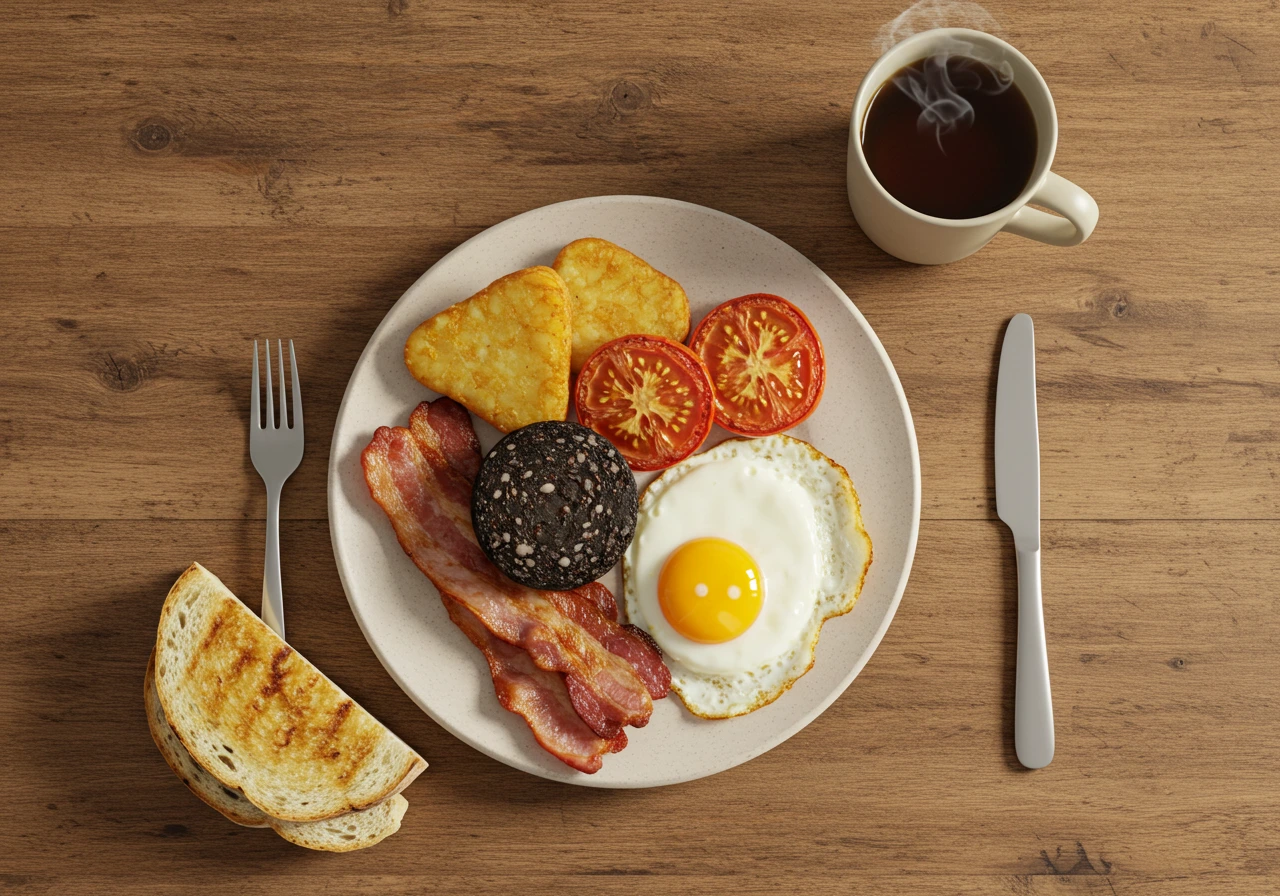The Ultimate Guide to Crafting Traditional Black Pudding Recipe
Welcome to this hearty journey through the rich flavors, stories, and secrets behind one of the most beloved dishes in traditional cuisine—black pudding. This article isn’t just another recipe breakdown; oh no, it’s a complete culinary and cultural dive into how this savory delicacy has fed generations and earned its place on breakfast tables across the UK and beyond.
Throughout this guide, you’ll discover step-by-step methods, regional variations, creative serving ideas, and nutritional insights. As someone who’s tried making this recipe firsthand, I’ll even walk you through what worked, what nearly flopped, and how you can avoid beginner mistakes. So grab your apron—and let’s roll up our sleeves.
Part 1: What Is Black Pudding?
Understanding the Traditional Blood Sausage
Let’s cut to the chase—black pudding isn’t your average sausage. At its core, it’s a savory blood sausage made from a blend of animal blood (typically beef or sheep), fat, and cereal grains like oatmeal or barley. These ingredients are seasoned with spices such as pepper, thyme, and marjoram, then carefully cooked and stuffed into casings.
But don’t let the ingredients intimidate you. Despite sounding “old-world” or a tad medieval, this dish is making quite the comeback thanks to foodies, chefs, and even wellness experts praising its iron-rich content and high protein profile.

In fact, it’s been labeled a superfood in recent years due to its dense nutritional value, although that’s a matter of ongoing debate in health circles. Either way, it’s safe to say—black pudding is anything but boring.
Why Black Pudding Is More Than Just a Sausage
Surprise, surprise! Black pudding isn’t only about nourishment; it’s deeply symbolic. In parts of the UK and Ireland, it evokes nostalgia—think early morning markets, farm-to-table meals, and hearty breakfasts cooked by your gran on chilly mornings.
More than just food, it’s a slice of cultural heritage that has held its ground through centuries of changing tastes and trends.
And let’s be honest, isn’t that what makes traditional recipes like this so special? They carry stories, they trigger memories, and they bring people together.
So the next time someone calls it just “blood sausage,” you’ll know it deserves a lot more respect.
A Curious Fact About Its Name
Ever wondered why it’s called “pudding” despite being meaty and savory? The term “pudding” comes from the French boudin, derived from the Latin botellus, meaning “small sausage.” In the UK, “pudding” can refer to both sweet and savory dishes, depending on the context. Thus, “black pudding” simply translates to a dark-colored savory sausage.
And hey, it does sound way more charming than “blood cake,” doesn’t it?
Exploring the Texture and Taste
If you’ve never tried it, you might be curious—what’s it like on the tongue?
Expect a tender, crumbly texture, kind of like a cross between firm stuffing and soft meatloaf. The taste? Earthy, slightly mineral, with a whisper of spice and that delightful umami depth from the blood and fat.
It’s a dish that hugs your taste buds, not punches them.
Modern Takes on a Traditional Classic
Today, this traditional sausage has crossed borders and bent rules. It’s used in gourmet dishes—crumbled over scallops, tucked into croquettes, or even shaped into plant-based alternatives for the modern table.
Yet, even in these innovative adaptations, the essence of black pudding remains untouched: bold, warming, and deeply satisfying.
If this first section already makes you hungry—good. Because we’re just getting started. In the next part, we’ll dig into how black pudding earned its place in history, from ancient feasts to contemporary breakfasts.
Get your spatulas ready.
Part 2: Understanding Black Pudding
What Is Black Pudding?
Let’s start with the basics. Black pudding is a traditional type of blood sausage, primarily made from a blend of animal blood (usually beef or lamb), suet or fat, and cereal grains such as oatmeal or barley. These core ingredients are mixed with seasonings—black pepper, allspice, marjoram, and even onions—to enhance flavor and aroma.
It’s shaped into sausages, stuffed into natural or synthetic casings, and typically boiled, steamed, or baked. The result? A deep, dark sausage with a tender bite and a rich, savory flavor that’s hard to resist. While the idea of using blood might seem unusual to some, historically it was a way to honor the animal and reduce waste—part of a nose-to-tail philosophy.
What sets black pudding apart is its firm yet crumbly texture. It holds together well when sliced but breaks gently on the plate. This makes it an ideal candidate not just for frying up in a hearty breakfast, but also for grating, crumbling, or even stuffing into other dishes. From farmers to foodies, everyone agrees—it’s more than just another sausage. It’s a dish that carries flavor, functionality, and folklore in every bite.
A Brief History of Black Pudding
Here’s where things get really interesting. Black pudding isn’t just old-school—it’s ancient. In fact, the earliest written mention of a dish resembling black pudding dates all the way back to Homer’s “The Odyssey.” Yup, we’re talking 8th century BC. In one passage, Homer describes a man turning a sausage filled with fat and blood over a fire—clearly not just your average poetry line.
This dish has been with us for millennia, evolving from early utilitarian meals into beloved regional fare. In medieval Europe, blood sausage was common across social classes, made right after slaughter to use up fresh blood that would otherwise spoil quickly. And while its core ingredients stayed the same, local spices and grains shaped the regional character of each version.
By the 15th century, black pudding had become a recognized term in the UK. Rural families made it as a way to stretch out meat and preserve energy-rich nutrients, especially during the cold months. Black pudding even appeared in British culinary texts as early as the 1600s.
Today, it’s proudly served in everything from breakfast platters to upscale bistros. Talk about surviving the test of time!
➡️ Learn more about the cultural roots in this detailed resource from the English Breakfast Society.
Cultural Significance Across Regions
Without a doubt, black pudding is woven into the fabric of British and Irish culture. It’s not just food—it’s tradition. And although it’s widely known as a staple in a Full English Breakfast, its role in society stretches far beyond the breakfast table.
In Northern England, particularly Lancashire and Yorkshire, it’s a local icon. You’ll find it at farmer’s markets, corner butchers, and even served cold in sandwiches. Meanwhile, Bury, a town in Greater Manchester, has carved out a name for itself as the black pudding capital of the UK—hosting its own Black Pudding Throwing World Championship (no joke!).
Head over to Scotland, and you’ll see it woven into traditional dishes like haggis and Scots fry-ups. Meanwhile, in Ireland, black pudding is taken just as seriously, often spiced more heavily and paired with white pudding (a similar sausage, but without the blood).
For centuries, these communities have celebrated black pudding not only for its taste but also as a symbol of resilience, frugality, and local pride. Generations of recipes have been passed down—some fiercely guarded, others freely shared.
Part 3: Nutritional Insights
Nutritional Profile of Black Pudding
Now, let’s get into the nitty-gritty—what’s in it for your body? While black pudding may have a bit of a rep for being indulgent, its nutritional profile might surprise you—in a good way.
On average, a 100g serving of black pudding delivers around 275–300 calories. The variation depends on the specific recipe and how it’s prepared. Some versions use more fat or grains, while others are leaner and cleaner. Still, it’s not the kind of food you’d down by the pound—it’s rich, filling, and usually eaten in modest portions.
Here’s how that typical 100g portion breaks down:
- Protein: ~15g
- Fat: ~22g (primarily from suet or tallow)
- Carbohydrates: ~3–5g (mostly from oatmeal or barley)
- Fiber: Minimal, though oatmeal adds a touch
- Cholesterol & Sodium: Moderate to high, so portion awareness is key
You’re also getting a robust dose of vitamin B12, zinc, and selenium—nutrients essential for brain function, immune support, and overall vitality. In fact, black pudding is one of the few breakfast items that can hold its own on a nutrient density chart.
Compared to typical sausages, it’s relatively low in carbohydrates and has more bioavailable iron. Sure, it’s not winning the “low-fat” trophy anytime soon, but as part of a balanced diet? It holds solid ground.
Health Benefits and Considerations
Alright, here’s where it gets exciting—and a bit nuanced. Despite its bold taste and bold ingredients, black pudding offers several health perks. For starters, it’s incredibly iron-rich. This is especially helpful for people who struggle with iron deficiency or anemia. One portion can pack up to 20% of your daily iron needs. That’s nothing to scoff at.
But that’s not all. Thanks to the animal blood content, it’s also high in heme iron—the kind that your body absorbs easily. This makes it more efficient than non-meat sources of iron like spinach or lentils.
Then there’s the protein factor. With around 15 grams per 100g, it’s a fantastic option for muscle maintenance, energy production, and even satiety. Pair it with some eggs and greens, and you’ve got yourself a hearty breakfast that sticks with you all morning.
However—and it’s a big however—there are things to keep in mind. The fat content, especially saturated fat, is on the higher side. So if you’re watching your cholesterol or dealing with cardiovascular concerns, it’s best enjoyed in moderation. Also, some store-bought versions may contain preservatives or be high in sodium. That’s why making it at home can be a game-changer—you control what goes in.
So, is black pudding healthy? It depends. If you’re looking for an iron-packed, protein-rich, and flavor-loaded food, this dish checks all the boxes. Just be mindful of the balance, and you’re golden.
Part 4: Preparing to Make black pudding recipe
Essential Ingredients for Traditional black pudding recipe
Before diving into the magic of sausage-making, let’s talk ingredients—the heart and soul of a great black pudding recipe. If you want flavor that feels like it’s been passed down through generations, then quality and freshness matter more than anything.
Here’s a traditional list of what you’ll need:

- Fresh Animal Blood (500ml) – Typically, beef or lamb blood is used. Pig’s blood is traditional, but it can be harder to find. Check local butchers or specialty meat suppliers, and always ensure it’s safe for consumption.
- Beef Suet or Fat (250g) – Suet gives black pudding that melt-in-your-mouth texture. It should be finely chopped or minced to distribute evenly.
- Steel-Cut Oats or Barley Groats (250g) – These provide body and a little chew. Oats are more common in British versions, while barley may be used in Irish recipes.
- Onions (1 medium, finely chopped) – Adds natural sweetness and depth.
- Salt (1 tsp) – To season and help preserve.
- Black Pepper (1 tsp) – Traditional for that warm, peppery kick.
- Marjoram and Thyme (optional, ½ tsp each) – For earthy undertones.
- Allspice or Nutmeg (¼ tsp) – Just a pinch adds subtle complexity.
🛒 Sourcing Tips: You might not find everything in your neighborhood supermarket, and that’s okay. Local butchers, farmers’ markets, or online gourmet shops often carry harder-to-source items like animal blood and natural casings. Always opt for the freshest blood possible—frozen is acceptable, but fresh delivers better flavor and texture.
Also, consider using organic or pasture-raised ingredients. Not only is it more ethical, but the flavor difference is absolutely worth it. Trust me—I tried it both ways.
If you’re nervous about using real blood, some vegetarian or “faux” versions use beetroot and black beans for color and protein. While not quite traditional, they’re creative alternatives for the adventurous cook.
Necessary Equipment and Tools
Making black pudding from scratch may sound like a big task, but with the right tools, it’s not as tricky as it seems. In fact, once your kitchen’s set up, the process flows smoothly.
Here’s what you’ll need:
- Large Mixing Bowl – To combine all your ingredients thoroughly.
- Sausage Casings – Natural (from beef or lamb) or synthetic. Natural casings provide a traditional texture and snap.
- Wide Funnel or Sausage Stuffer – Crucial for filling casings evenly without mess.
- Butcher’s Twine – To tie the ends of your sausages securely.
- Large Saucepan or Stock Pot – For poaching the sausages gently. Make sure it’s deep enough so they’re fully submerged.
- Thermometer (optional but recommended) – To monitor water temperature and avoid overcooking or splitting.
- Skimmer or Slotted Spoon – Handy for lifting sausages out safely.
✨ Pro Tip: If you’re just starting out and don’t want to invest in a sausage stuffer, you can rig a homemade one using a funnel, a spoon, and a lot of patience. Trust me—I tried this route the first time, and while it was slower, it still worked!
With everything prepped, you’re one step closer to creating homemade black pudding recipethat’s bursting with flavor, tradition, and satisfaction.
Part 5: Step-by-Step Black Pudding Recipe
Preparing the Ingredients
Once you’ve sourced everything you need, it’s time to roll up your sleeves and get messy—in the best possible way. Preparing the ingredients for black pudding is a ritual. It’s not rushed, it’s not robotic—it’s mindful, hands-on cooking at its most primal.

Here’s how to get started:
- Soak the oats or barley: Begin by soaking your steel-cut oats in warm water for about 30 minutes. This softens them up so they don’t soak up too much liquid from the blood later.
- Mince the fat: Your beef suet or other fat should be finely chopped or minced until it resembles coarse breadcrumbs. This ensures even distribution throughout the mixture and prevents clumps.
- Sauté the onions: Gently cook your chopped onion in a little oil or rendered fat over low heat until translucent. This removes the sharpness and adds a mellow sweetness.
- Strain the blood (if needed): If your blood has clots, strain it through a fine sieve. This makes it smooth and easier to mix. Use gloves if you’re squeamish—no shame in the game.
- Combine the ingredients: In a large bowl, gently mix together the blood, oats, suet, sautéed onions, and your chosen seasonings (salt, pepper, marjoram, allspice, etc.). Stir slowly to keep the mixture airy. You’re looking for a loose, thick batter—not runny, but not stiff either.
And there you have it. Everything is ready to be cased and cooked. At this point, it already smells earthy and inviting—and you haven’t even fired up the stove yet.
Cooking Methods Explored
Now comes the moment where your kitchen turns into a traditional cookhouse. Cooking black pudding recipe isn’t difficult, but it does require attention to temperature and timing. One wrong move and you’ll burst your beautiful sausages. But don’t stress—we’ve got you.
Traditional Poaching (Boiling) Method:
- Prepare the casings: If using natural sausage casings, rinse them in cold water and then soak for 30 minutes. Run water through them to remove any salt or debris.
- Fill the casings: Using a sausage stuffer or wide funnel, fill the casing with the black pudding mixture. Don’t pack it too tight! Leave about an inch on each end and tie with butcher’s twine.
- Set up the water bath: Fill a large pot with water and heat it to around 80–85°C (175–185°F). Do not boil—it will cause the casings to split.
- Poach gently: Submerge the sausages and cook for 30–45 minutes, depending on size. Use a skimmer to check doneness—a firm texture indicates they’re ready.
- Cool immediately: Transfer them to a bowl of cold water or place on a wire rack to cool. This stops cooking and helps them set.
Alternative Methods:
- Oven Baking: Place the mixture in loaf tins (lined with parchment) and bake at 160°C (320°F) for about 90 minutes in a water bath. This method gives you sliceable puddings with a firmer texture.
- Steaming: Place wrapped sausages in a steamer basket over simmering water. Great for maintaining a moist, delicate finish.
Each method yields slightly different textures, so feel free to experiment and find your personal favorite.
🧠 Pro Tip: Try the poaching method first for the most traditional result. If you’re nervous about the casings splitting, test one sausage before committing the whole batch.
Personal Experience with the Recipe
I still remember the first time I made black pudding recipe from scratch—it was chaotic, a bit messy, and absolutely magical.
I sourced the blood from a local butcher who looked at me with a mix of surprise and admiration. When I got home, the smell of spices blending into warm oatmeal and onions transported me straight into a rustic farmhouse kitchen, even though I was standing in a modern city flat.
Here’s what I learned from trial and error:
- Don’t overfill the casings. My first batch exploded like sad little sausages because I packed them too tightly. Leave room for expansion!
- Control the heat. Simmer, don’t boil. The moment water starts bubbling, turn the heat down.
- Mix slowly and gently. I stirred too aggressively at first, which made the texture a little rubbery. A delicate fold is better than a heavy hand.
And honestly? The result was worth every second. That first bite—crispy outside, crumbly and rich inside—was deeply satisfying. It had that umami punch, with a peppery warmth and the kind of texture that feels old-school comforting.
So yes, while black pudding might look intimidating at first, once you try it, you’ll understand why it’s been loved for centuries.
Part 6: Serving and Pairing Suggestions
Classic Dishes Featuring black pudding recipe
When it comes to classic meals, black pudding isn’t just a sidekick—it’s often the star. For many in the UK and Ireland, the most iconic pairing is undoubtedly the Full English Breakfast. You know the one: crispy hash browns, grilled tomatoes, buttery toast, runny eggs, and nestled right in the middle—a sizzling slice of black pudding, pan-fried to perfection.
This breakfast isn’t just about variety; it’s about balance. The richness of the pudding plays beautifully against the sharp tang of tomatoes and the creamy comfort of scrambled eggs. And when the yolk spills across a crisped slice? Magic.

Other traditional combos include:
- Black pudding with mashed potatoes and onions – sometimes served with a mustard or onion gravy in Irish pub fare.
- Scottish breakfast fry-up – paired with tattie scones, baked beans, and lorne sausage.
- Potato cakes and black pudding – a lesser-known but beloved option in the north.
Oh, and don’t forget black pudding butties (sandwiches). Add a layer of ketchup or brown sauce between two slices of crusty bread, and you’ve got a handheld hero worthy of a standing ovation.
No matter how it’s served, black pudding brings an earthy, savory edge that ties everything together. It doesn’t shout—it hums, creating harmony on the plate.
Innovative Culinary Uses
Modern chefs have taken the humble black pudding and turned it into a gourmet ingredient—and you can too. Its bold flavor and unique texture make it perfect for dishes that need a little punch or a surprising twist.
Let’s start with salads. Crumbled black pudding recipe tossed with warm roasted beets, goat cheese, and baby spinach? Absolute game-changer. The rich, spiced sausage offsets the sweetness of the beets and the tang of the cheese, elevating a simple dish into something memorable.
Another standout is the black pudding recipe and apple crostini. Imagine thin slices of toasted baguette topped with a smear of apple chutney, a medallion of black pudding, and a sprinkle of microgreens. It’s salty, sweet, and crunchy—all at once.
Other creative applications:
- Stuffed chicken breasts – black pudding combined with breadcrumbs and herbs, then rolled into chicken fillets.
- Scallops with black pudding – a fine dining classic. The sweetness of seared scallops paired with a crispy black pudding disc is culinary poetry.
- Pizza topping – yes, really. Add a little to a wood-fired pizza with caramelized onions and blue cheese. It’s a bold move—but worth it.
➡️ Explore even more unique recipe ideas from The Scottish Butcher’s guide to black pudding dishes.
So, whether you’re frying it up for a weekend breakfast or slipping it into your next appetizer tray, black pudding proves that traditional doesn’t mean boring—it means versatile.
Part 7: Frequently Asked Questions
When it comes to black pudding recipe, there’s a mix of curiosity, confusion, and a fair bit of myth floating around. So, let’s clear the air and answer some of the most commonly asked questions people have about this iconic dish. Whether you’re a first-time taster or a nostalgic foodie, this FAQ will bring clarity with a dash of flavor.
What is black pudding made of?
At its core, black pudding is a type of blood sausage. The traditional recipe calls for a mixture of animal blood (typically from cows or sheep), fat or suet, and a grain such as oatmeal or barley. It’s seasoned with salt, pepper, and regional spices like marjoram, thyme, or nutmeg. The ingredients are combined into a batter-like consistency and then either cased into sausages or baked into loaves.
This combination results in a bold, earthy, and slightly spicy taste with a unique texture—firm on the outside, soft and crumbly on the inside. The oats give it structure and chew, while the blood provides that deep umami note.
Why is blood pudding illegal in the US?
Ah, the age-old mystery. Contrary to popular belief, black pudding recipe itself isn’t completely illegal in the United States. However, it’s extremely hard to find due to strict USDA regulations around the sale and transport of fresh animal blood for human consumption.
In essence, the ban stems from food safety concerns, especially around sourcing and storing fresh blood. Since the U.S. doesn’t have a widespread regulatory system for monitoring blood intended for food use, it’s easier to just prohibit its commercial use.
That said, homemade black pudding or products imported under specific licenses can legally exist—it’s just rare, expensive, and tightly controlled.
What is black pudding recipe called in America?
In most of the U.S., black pudding keeps its name among culinary enthusiasts and specialty butchers. However, it’s sometimes generically referred to as blood sausage, especially in multicultural areas or gourmet shops.
You may also find it under international variations:
- Boudin noir (France)
- Morcilla (Spain and Latin America)
- Blutwurst (Germany)
Each has its unique twist, but they all share that defining ingredient—blood.
Is black pudding recipe healthy or not?
Here’s the straight talk: black pudding can be part of a healthy diet—when eaten in moderation.
Pros:
- Rich in heme iron, which your body absorbs more easily than plant-based iron.
- High in protein—around 15g per 100g.
- Contains essential nutrients like zinc, vitamin B12, and selenium.
Cons:
- It’s often high in saturated fat due to the inclusion of suet or animal fat.
- Sodium levels can be quite high in commercial versions.
- Store-bought varieties may include preservatives or fillers.
So, is it healthy? Well, it’s definitely more nutrient-dense than many processed meats or sugary breakfast items. But balance is key. If you’re conscious about cholesterol or sodium, consider making your own black pudding recipe with leaner fat ratios and natural ingredients.
Bottom line: enjoy it occasionally, not excessively, and you’ll reap the rich, meaty rewards without tipping the health scale.
Embracing the Rich Tradition of black pudding recipe
From humble beginnings as a method of resourceful cooking to its current status as a celebrated delicacy, black pudding has stood the test of time—and for good reason. This bold, hearty dish is more than just a blood sausage. It’s a culinary storyteller, connecting us to centuries of food culture, sustainability, and regional identity.
Whether enjoyed as part of a classic full English breakfast, reinvented in a fine-dining dish, or lovingly made at home from scratch, black pudding offers a taste that’s both familiar and unexpected. Its deep flavors, nutritional benefits, and adaptability across meals make it a dish worth preserving—and savoring.
So go ahead, try your hand at making it, serve it with pride, and pass the tradition on. Because sometimes, the most rustic recipes carry the richest rewards. And in the case of black pudding? Every bite tells a story.

